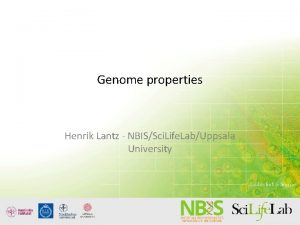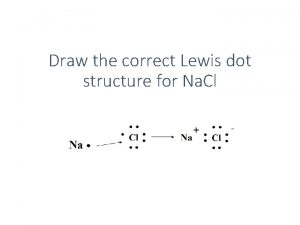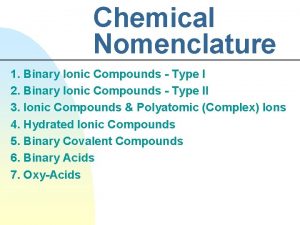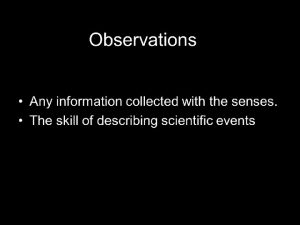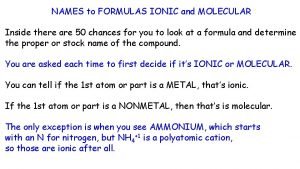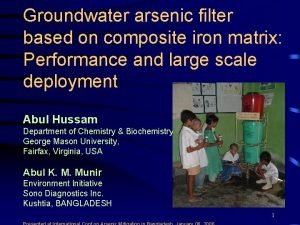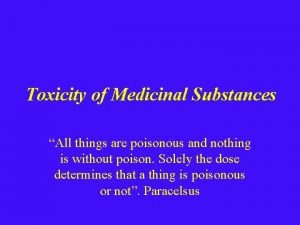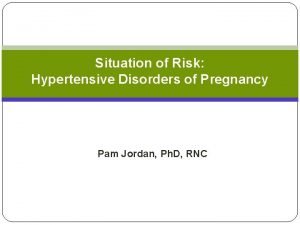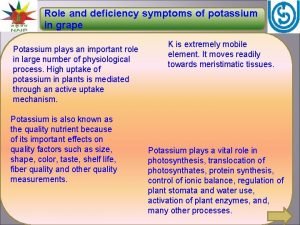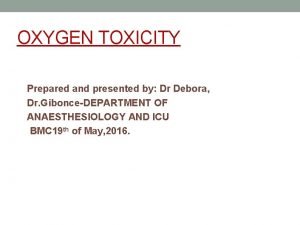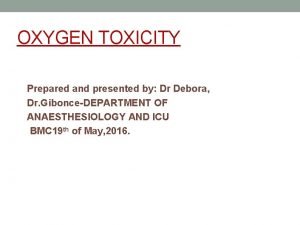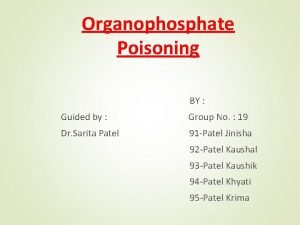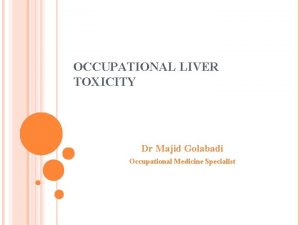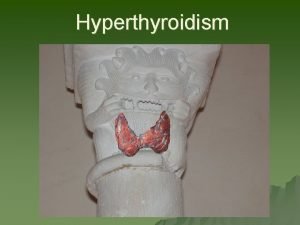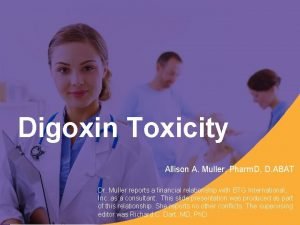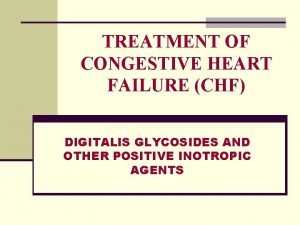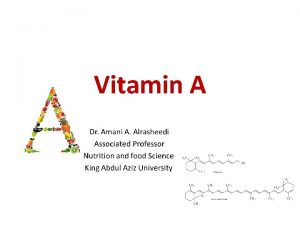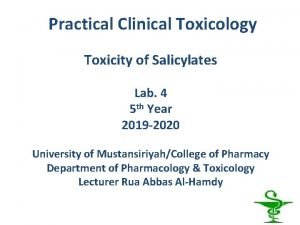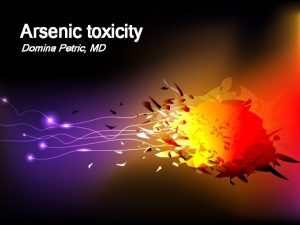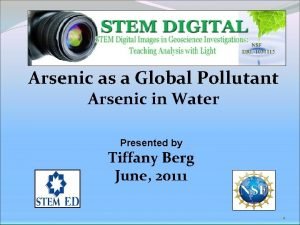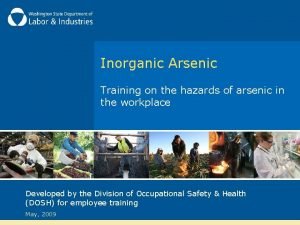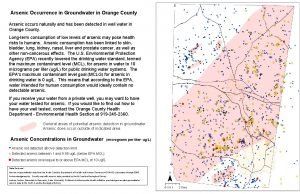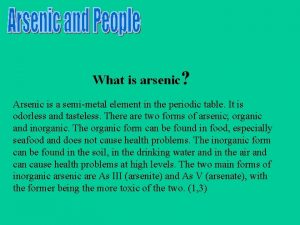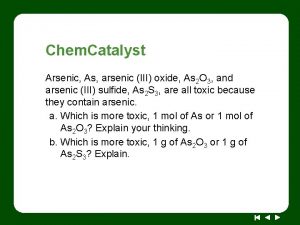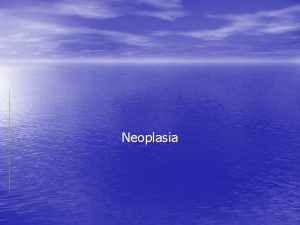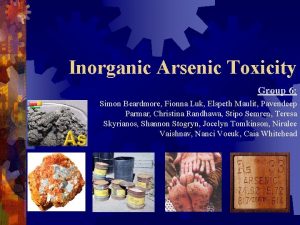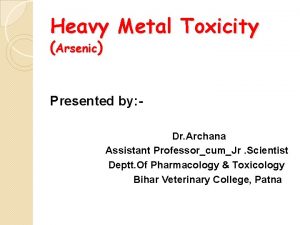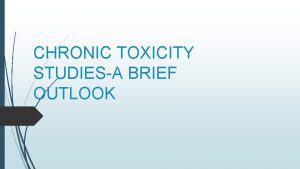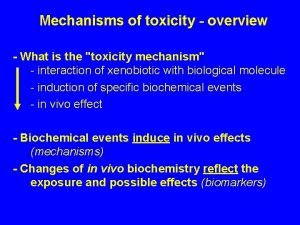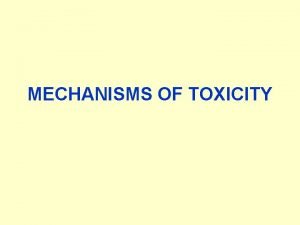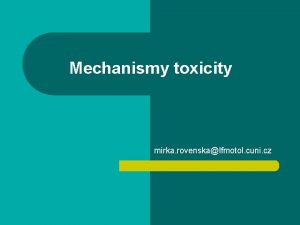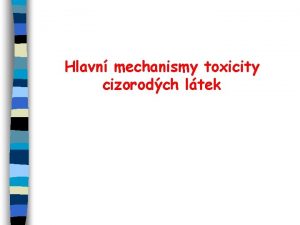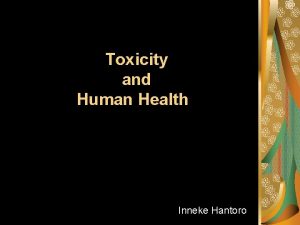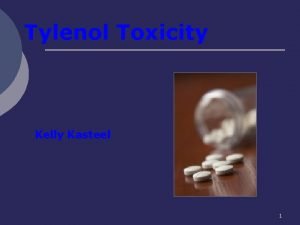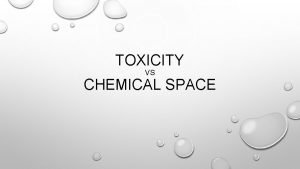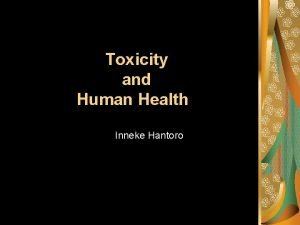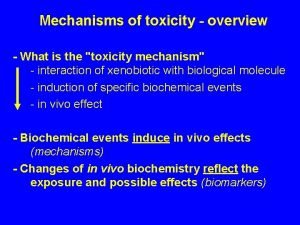Toxicity of Arsenicals Clark Lantz Introduction Arsenic is








































- Slides: 40

Toxicity of Arsenicals Clark Lantz

Introduction • Arsenic is widespread in the environment • Occupational exposures can occur – Smelting industry – Coal fired power plants • Epidemiological studies implicate arsenic as a carcinogen • Inhalation is a common route of exposure • Drinking water exposure can also lead to cancer

History • 50 ppb ( g/L) has been the standard for arsenic in drinking water in US since 1942 • Adopted as an interim standard by US EPA in 1974 • SDWA 1986 required EPA to set a final standard • In 1996, EPA was required by Congress to set a standard by 2000

History • Based on existing published data, EPA proposed a MCLG (maximum containment level goal) of 0 ppb and an MCL (maximum containment level of 5 ppb) – EPA was required to consider cost/benefit analysis in setting the final rule • EPA requested comments in summer of 2000 – Could comment on the MCLG, or on an MCL of either 3, 5, 10 or 20 ppb

History • Just prior to the change in administration, EPA published the final rule as MCLG=0 ppb and MCL=10 ppb • The new rule has been suspended by the Bush administration and is currently under re-review

What data did EPA use to set the new rule? • In 1960 s, published data from Taiwan indicated that arsenic in drinking water could cause skin cancer • These data and additional data collected from this region have been the primary sources of establishing arsenic in drinking water as a cause of skin, lung and bladder cancer • Data have been supported by data from South American studies

What data did EPA use to set the new rule? • EPA also did a cost estimate of meeting the new rule standards • Compared cost with the health benefits that would be obtained by lowering to 10 ppb (20 -30 lives/year) • Balance between cost and benefit, EPA arrived at 10 ppb for MCL. No change in MCLG of 0 ppb.

Why all the uproar? Within the exposure range of 2 -20 ppb • Values are close to background exposure. • Values are close to toxic events (small safety factor) • Costs to remediate are greater as the value goes lower

Why all the uproar? • Data showing cancer in Taiwan population was obtained at high doses (100 - 2000 ppb). – Actual analysis showed that exposure above 400 ppb resulted in cancer – EPA extrapolated from this point to low doses • The shape of the dose-response curve may be sublinear – EPA assumed a linear dose-response curve extrapolated to zero – Large percentage of investigators believe the dose-response curve to be sublinear

Setting the MCL (Effect of MCLG) Cancer POD=400 ppb MCLG=0 ppb Arsenic levels in water X

Setting the MCL (Sublinear Dose-Response) Cancer POD=400 ppb MCLG=0 ppb Arsenic levels in water X

Determining the mechanism of action • Animal studies have been negative • Not sure what form of arsenic is the carcinogenic species

Arsenic Metabolism Arsenate (V) GSH Arsenite (III) Methyltransferase MMA(V) Reductase SAM Reductase GSH Methyltransferase DMA(V) MMA(III) SAM

Multistage Carcinogenesis Cell cycle checkpoints DNA repair NORMAL CELL INITIATED CELL Single DNA mutation CELL DEATH Growth factors CANCER

Multistage Carcinogenesis Cell cycle checkpoints DNA repair NORMAL CELL X INITIATED CELL Single DNA mutation Arsenic is not mutagenic Arsenic is a co-carcinogen CELL DEATH Growth factors CANCER

Proposed modes of action • Alteration in DNA repair • Changes in DNA methylation • Suppression of cell cycle check point proteins (p 53) • Altered expression of growth factors • Oxidative stress

Arsenic-induced oxidative stress • Arsenic may cycle between oxidative states, producing radicals • Arsenic may interact with and reduce intracellular levels of antioxidants • Arsenic may increase inflammation, leading to chronic presence of cells that produce radicals and/or growth factors

OVERALL OBJECTIVES • To determine if arsenicals will lead to oxidative stress • To determine if exposure to arsenicals can lead to oxidative damage by initiating pulmonary inflammation.

• Is there a correlation between inflammation and arsenic-induced genotoxic events? • Does inflammatory cell oxygen radical production produce genotoxicity and cell proliferation? • Will inhalation of environmental levels of arsenicals produce similar inflammation and genotoxicity? • Is there synergism between arsenic and other pulmonary carcinogens? • Does exposure to arsenic alter inflammatory mediator expression?

Will inhalation of arsenicals lead to increased inflammation and oxidative stress? • Male Syrian golden hamsters were exposed for 5 days by nose-only inhalation to 200 g/m 3 TWA of either calcium arsenate, arsenic trisulfide or arsenic trioxide and/or primary cigarette smoke. • BALF was analyzed for indicators of inflammation by determining total cell counts and TNF concentrations. • PAM were analyzed for their ability to produce superoxide and TNF. • Whole lung GSH levels and DNA oxidation were used to evaluate oxidative stress

BALF Cell Counts after 5 day inhalation exposure

Glutathione and DNA oxidation following 5 days inhalation exposure

Will inhalation of arsenicals lead to increased inflammation and oxidative stress? • Inhalation of arsenicals at realistic environmental exposure levels does not lead to inflammation • PAM lavages from animals after 5 day exposure do not show any differences in superoxide or TNF production compared to controls. • Combined exposure to arsenic and cigarette does not lead to increased inflammatory response. However, it does lead to decreased GSH levels.

Will inhalation of arsenicals lead to increased inflammation and oxidative stress? • Male Syrian golden hamsters were exposed for 28 days by nose-only inhalation to 200 g/m 3 TWA of arsenic trioxide and/or primary cigarette smoke. • BALF was analyzed for indicators of inflammation by determining total cell counts. Histological tissue sections were also examined for signs of inflammation. • Levels of total, reduced and oxidized glutathione were determined. • DNA oxidation was determined as an indicator of genotoxicity.

Cell Counts after 28 day inhalation exposure A

Total Glutathione after 28 day inhalation exposure A

DNA Oxidation after 28 day inhalation exposure

Will inhalation of arsenicals lead to increased inflammation and oxidative stress? • Inhalation of arsenicals at realistic environmental exposure levels does not lead to inflammation • Inhalation of arsenicals or cigarette smoke alone at the exposures studied, does not lead to alterations in GSH or in DNA oxidation. • Combined exposure to arsenicals and cigarette smoke significantly reduces GSH as early as 5 days after beginning exposure. • Significant increases in DNA oxidation are seen after 28 day exposures. • Effects of combined exposure to arsenic and cigarette smoke does not appear to be due to increased inflammatory response.

Can arsenic activate oxidative stress sensitive transcription factors? • Rat lung slices were exposed to arsenite (0. 1 to 100 M) for up to 24 hr. • Nuclear proteins were isolated analyzed transcription factors c-Jun/AP-1 and p 65 NF B by Western and EMSA • HSP protein expression was also analyzed (HSP-32, 60, 72 and 90) • Immunohistochemistry was used to identify the cells affected by the arsenic exposure

Levels of expression

CONTROL AP-1 ARSENIC

CONTROL NF B ARSENIC

Can arsenic activate oxidative stress sensitive transcription factors? c-Jun/AP-1 was activated at 1 M. p 65 NF B was not translocated to the nucleus HSP-32 (HOX-1) was upregulated Other HSPs were either not affected of only increased at high arsenic concentrations • Up regulation of AP-1 and HSP-32 were seen in PAM, EPII and endothelial cells. • •

Effect of arsenic exposure in vitro on PGE 2 production

Overall Conclusions • Arsenic at environmentally relevant levels does cause oxidative stress in the lung – Changes in GSH – Activation of oxidative stress sensitive transcription factors – Expression of HOX-1 – Is not due to release of oxygen radicals by inflammatory cells • Exposure to arsenic can potentiate the response following exposure to a second toxicant.

Levels of expression

Future Questions • What is the cellular site(s) of action that lead to synergistic effects? • Does the response depend on the chemical form of arsenic? • What is the time course for development of the responses?

Other concerns with EPA rule • Taiwan data used “ecological” values for the dose • US based studies (Utah study) have not demonstrated increased cancer associated with arsenic in the water (0 -100 ppb) • EPA underestimated costs associated with treatment, particularly in the Southwest • EPA proposed best treatment will probably not work for Southwestern US water treatment

Issues for Arizona water companies • The economic effect will depend on the location within the state. – Only about 10% of Tucson Water wells exceed 10 ppb – However, some companies in the Phoenix area are already having problems meeting 50 ppb – Cost of treatment would be prohibitive for small companies – Small companies may be abandoned

Lantz lab Grace Parliman Guan Jie Chen Padma Sundareshan Jayanthika Wijeweera Carter lab Dr. Dean Carter David Barber Michael Kopplin Felix Ayala Witten lab Dr. Mark Witten Allison Hays Madel Balagtas Funded by NIH R 01 ES 05561 NIH P 30 ES 06694 ADCRC 9703
 Clark and clark marketing functions
Clark and clark marketing functions Didier lantz
Didier lantz Henrik lantz
Henrik lantz суперспринт agile
суперспринт agile Todd lantz
Todd lantz Henrik lantz
Henrik lantz Potassium lewis dot diagram
Potassium lewis dot diagram Sophomoric humor meaning
Sophomoric humor meaning Ground state electron configuration of arsenic
Ground state electron configuration of arsenic Lewis structure for arsenic
Lewis structure for arsenic Binary ionic
Binary ionic Ground state of arsenic
Ground state of arsenic Water attack test is only used for glass containers.
Water attack test is only used for glass containers. Francois emanuel fodere
Francois emanuel fodere Formula for arsenic pentabromide
Formula for arsenic pentabromide Atomic radius periodic trend
Atomic radius periodic trend Shorthand electron configuration for arsenic
Shorthand electron configuration for arsenic How to write ammonium phosphate
How to write ammonium phosphate Sono arsenic filter
Sono arsenic filter B6 toxicity symptoms
B6 toxicity symptoms Mcgreafor
Mcgreafor Definition of chronic toxicity
Definition of chronic toxicity Vitamin d toxicity
Vitamin d toxicity Severe preeclampsia criteria
Severe preeclampsia criteria Plant name
Plant name Oxygen poisoning
Oxygen poisoning What is oxygen toxicity
What is oxygen toxicity Features of op poisoning
Features of op poisoning Hepatic toxicity
Hepatic toxicity Lithium toxicity
Lithium toxicity Methimasole
Methimasole Which pictogram represents acute toxicity
Which pictogram represents acute toxicity Definition of chronic toxicity
Definition of chronic toxicity Digoxin
Digoxin Kaexylate
Kaexylate Anticholinergic toxicity
Anticholinergic toxicity Alcohol toxicity
Alcohol toxicity Vitamin c digestion and absorption
Vitamin c digestion and absorption Digoxin toxicity symptoms
Digoxin toxicity symptoms Function of vitamin a
Function of vitamin a Treatment of salicylate toxicity
Treatment of salicylate toxicity


